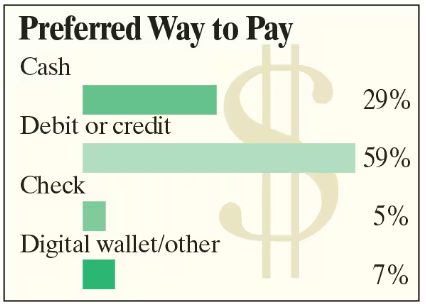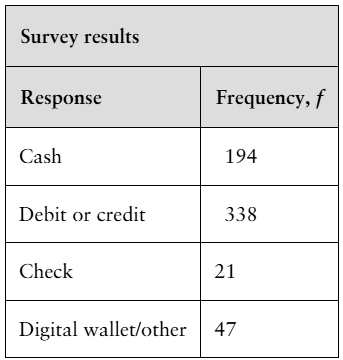Table of contents
- 1. Intro to Stats and Collecting Data55m
- 2. Describing Data with Tables and Graphs1h 55m
- 3. Describing Data Numerically1h 45m
- 4. Probability2h 16m
- 5. Binomial Distribution & Discrete Random Variables2h 33m
- 6. Normal Distribution and Continuous Random Variables1h 38m
- 7. Sampling Distributions & Confidence Intervals: Mean1h 3m
- 8. Sampling Distributions & Confidence Intervals: Proportion1h 12m
- 9. Hypothesis Testing for One Sample1h 1m
- 10. Hypothesis Testing for Two Samples2h 8m
- 11. Correlation48m
- 12. Regression1h 4m
- 13. Chi-Square Tests & Goodness of Fit1h 20m
- 14. ANOVA1h 0m
13. Chi-Square Tests & Goodness of Fit
Goodness of Fit Test
Problem 10.1.10d
Textbook Question
Performing a Chi-Square Goodness-of-Fit Test
In Exercises 7ŌĆō16, (d) decide whether to reject or fail to reject the null hypothesis.
Ways to Pay A financial analyst claims that the distribution of peopleŌĆÖs preferences on how to pay for goods is different from the distribution shown in the figure. You randomly select 600 people and record their preferences on how to pay for goods. The table shows the results. At ╬▒=0.01, test the financial analystŌĆÖs claim. (Adapted from Travis Credit Union)


 Verified step by step guidance
Verified step by step guidance1
Step 1: State the null and alternative hypotheses. The null hypothesis (HŌéĆ) is that the distribution of people's preferences for payment methods matches the distribution shown in the figure. The alternative hypothesis (HŌéü) is that the distribution of people's preferences for payment methods is different from the distribution shown in the figure.
Step 2: Calculate the expected frequencies for each payment method based on the percentages provided in the figure and the total sample size of 600 people. Use the formula: Expected frequency = (Percentage from figure / 100) ├Ś Total sample size. For example, for 'Cash', the expected frequency is (29 / 100) ├Ś 600.
Step 3: Compute the Chi-Square test statistic using the formula: Žć┬▓ = ╬Ż((Observed frequency - Expected frequency)┬▓ / Expected frequency). For each payment method, subtract the expected frequency from the observed frequency, square the result, divide by the expected frequency, and sum these values across all categories.
Step 4: Determine the degrees of freedom (df) for the test. The degrees of freedom are calculated as: df = Number of categories - 1. In this case, there are 4 payment categories, so df = 4 - 1 = 3.
Step 5: Compare the calculated Chi-Square test statistic to the critical value from the Chi-Square distribution table at ╬▒ = 0.01 and df = 3. If the test statistic exceeds the critical value, reject the null hypothesis; otherwise, fail to reject the null hypothesis.
 Verified video answer for a similar problem:
Verified video answer for a similar problem:This video solution was recommended by our tutors as helpful for the problem above
Video duration:
5mPlay a video:
Was this helpful?

 1:17m
1:17mWatch next
Master Goodness of Fit Test with a bite sized video explanation from Patrick
Start learning


